Welcome!
Welcome to the online open house for the Draft PEIS for green hydrogen production and storage facilities in Washington state. This online open house includes links to sections of the Draft PEIS and technical reports.
Thank you for providing your input during the public comment period, which ran from 12:00 p.m. January 7 through 11:59 p.m. February 6, 2025. We hosted three online public hearings on January 23, 28, and 30, where we presented findings, answered questions, and took public comment.
Visit Ecology's PEIS webpage for more information.
Background
The Washington State Legislature directed Ecology to prepare a broad environmental review that assesses and discloses the probable significant adverse environmental impacts that green hydrogen facilities may pose in Washington. Ecology also evaluated related measures designed to avoid and reduce impacts.
View PEIS Section 1.2Green Hydrogen
The term "green hydrogen" includes the following types of hydrogen:
- Green electrolytic hydrogen is hydrogen produced through electrolysis using electricity to break apart water and create hydrogen and oxygen. This definition allows for renewables and fossil fuels to be used as a source of electricity with the amount of fossil fuels decreasing over time to meet state greenhouse gas limits.
- Renewable hydrogen is hydrogen produced using renewable resources both as the source for the hydrogen and the source for the energy input into the production process. This is produced using steam-methane reforming, pyrolysis, or bio-gasification processes.
Green hydrogen energy facilities help support the state's transition to clean energy. When green hydrogen replaces fossil fuels for uses such as transportation fuels and industrial heating it helps to reduce overall greenhouse gas emissions in Washington.
What is a PEIS?
Eccology developed the Draft PEIS to provide consistent and useful information that the public, local and state agencies, Tribes, and developers can use to help plan and review projects. This statewide planning document is not specific to any single project. Each individual project will still need a separate environmental review as determined by the lead agency.
View PEIS Section 1.1What is a PEIS?
- Provide a review at a broad level
- Analyze potential impacts
- Look at ways to avoid impacts through siting and project design
- Identify possible mitigation
- Provide consistent information
- Approve or deny a project
- Evaluate a specific project
- Analyze a specific location
- Take away any state or local agency authorities
Goals of the Draft PEIS
- Support the state's clean energy transition while protecting the environment, Tribal rights and resources, and local communities.
- Identify probable significant adverse environmental impacts green hydrogen facilities can pose.
- Identify general potential mitigation measures for impacts.
- Provide information for siting and design that may be used to help avoid or minimize adverse environmental impacts in future proposed projects.
- Provide information for lead agencies to consider when conducting environmental reviews for green hydrogen facilities.
Goals of the Draft PEIS
Programmatic Environmental Review - We are here!
- Planning level
- General description of potential impacts and mitigation
Project-level Environmental Review
- Individual project level
- Identification of specific potential impacts and mitigation measures
Project Permitting
- Individual project compliance
- Detailed permit conditions, detailed mitigation design and monitoring
 Overview of Hydrogen
Overview of Hydrogen
Hydrogen is abundant on earth as an element but is almost always found as part of another compound, such as water or methane. It must be separated into pure hydrogen for use as energy. It can be stored and transported as a gas or liquid. Hydrogen as a fuel contains a high level of energy per unit of mass, more than natural gas or gasoline. The U.S Department of Energy and the National Renewable Energy Laboratory websites provide information on green hydrogen.
View PEIS Section 2.2Green Hydrogen Uses
- Chemical and industrial operations, including at petroleum refineries, for industrial chemical processes, and iron and steel production where high-temperature heat is needed
- Creation of other products, including alternative jet fuel, green ammonia, and green methanol
- Fuel source for vessel aircraft, freight rail, and heavy-duty vehicles
- Power and heat generation
Currently, hydrogen is mainly used for petroleum refining and production of bulk chemicals, such as ammonia. The United States produces approximately 10 million metric tons of hydrogen annually. Most hydrogen comes from a process called steam-methane reforming where fossil fuels are used as the feedstock. This hydrogen is often called gray hydrogen.
Hydrogen Safety
Human senses cannot detect a hydrogen leak, so sensors are used. Facilities must be properly ventilated to reduce hydrogen gas accumulation in the event of a leak or spill. Using proper materials and safety equipment and implementing engineering controls and safety procedures help reduce risks.
Safety requirements include setbacks from adjacent structures and requirements for the types of material used for processing equipment and storage. New building codes and other technical standards specific to hydrogen may not be included in local codes. The PEIS describes current requirements and where there are gaps.
Green Hydrogen Facility Types
The PEIS evaluates green hydrogen production facilities, production facilities with battery energy storage systems, green hydrogen storage facilities, and a No Action Alternative.
View PEIS Section 2.5Production Facility
A green hydrogen production facility would produce hydrogen using one of the following processes:
-

Electrolysis:
A process that uses electricity to split water into hydrogen and oxygen. -

Steam-methane reforming:
Green hydrogen produced from this process would use renewable natural gas as the primary fuel source. -

Pyrolysis:
Occurs when methane from renewable natural gas or biomass is heated and decomposed, creating hydrogen and solid carbon. -

Bio-gasification:
A controlled process involving heat, steam, and oxygen to convert biomass into hydrogen and other products.
The PEIS evaluates production facilities with a footprint of 1 to 10 acres and structures up to 100 feet in height. A facility would typically include a connection to the electricity grid to power all, or a portion of, the facility's production, equipment needs, and buildings.
Production Facility with Co-located Battery Energy Storage
The PEIS analyzed up to two co-located containers with lithium-ion battery systems used to balance loads or to provide power in case of an outage or power quality deviation. Each container would be approximately 60 feet long, 12 feet wide, and 10 feet tall. They would be located on concrete pads or in larger buildings and constructed in compliance with state structural and electrical code requirements.
Storage Facility
A green hydrogen storage facility could store hydrogen in gas or liquid form. If co-located with a production facility, the storage method used would be selected based on the amount of hydrogen generated and the associated on-site storage needs:
- Green hydrogen in a gas form would be stored in stationary, above ground, cylindrical or spherical tanks.
- Green hydrogen in a liquid form would be stored in double-walled, vacuum-insulated cryogenic (very low temperature) storage tanks.
In general, liquid hydrogen storage requires a smaller area to store the same capacity of gaseous hydrogen, although it requires the addition of a liquefaction system. A green hydrogen storage facility may be co-located with a green hydrogen production facility, a standalone facility, or end-use location such as an industrial facility or fueling facility.
No Action Alternative
Agencies would continue to conduct environmental review and permitting for green hydrogen facilities under existing laws on a project-by-project basis without using this PEIS as a reference.
Scope of Study
View PEIS Section 3The geographic scope for the PEIS includes areas throughout the state of Washington where green hydrogen facilities are likely to be developed based on available transmission lines, proximity to freight highway routes, and industrial or industrial-use supporting zoning. These lands include city and county industrially zoned areas or areas zoned to support industrial uses, such as areas with major port facilities that handle freight shipments, intermodal facilities, and airports.
The PEIS considers green hydrogen facilities that may be constructed after June 30, 2025, and before January 1, 2050 and facilities are expected to have an operational life of 20 to 50 years. The study uses an approximate 75-year time period for the resource analyses.
PEIS Structure and Impact Analysis
View PEIS Section 4Summary
The summary provides brief, high-level information on key findings for probably significant adverse impacts.
Key findings are provided in the following slides.
Chapters
The PEIS chapters provide information on the impact analysis and findings.
Links to each chapter can be found on the following slides.
Technical Appendices
The technical appendices contain detailed methods and technical documentation for the PEIS analysis.
The Technical Appendixes can be found on the PEIS publication page.
Resources Evaluated
- Tribal rights, interests, and resources
- Environmental justice and overburdened communities
- Earth resources
- Air quality and greenhouse gases
- Water resources
- Biological resources
- Energy and natural resources
- Environmental health and safety
- Noise and vibration
- Land use
- Aesthetics and visual quality
- Recreation
- Historic and cultural resources
- Transportation
- Public services and utilities
- Cumulative impacts
Significance of Impacts
The PEIS focuses on significant adverse environmental impacts. Significance considers the intensity and context of the impact and would vary by project.
For many resources, impacts are presented as a range of less than significant to potentially significant.
Individual projects will need a project-specific environmental review to determine the level of impact and mitigation approaches.
Impacts can be reduced through compliance with laws and permits, and with implementation of actions that could avoid and reduce impacts:
- Siting and design considerations
- Permits, plans, and best management practices
- Additional mitigation measures
 Tribal Rights, Interests, and Resources
Tribal Rights, Interests, and Resources
Tribal rights, interests, and resources refer to the collective rights and access to traditional areas and times for gathering resources associated with a Tribe's sovereignty since time immemorial. They include inherent rights or formal treaty rights associated with usual and accustomed territories. Tribal resources include Tribal cultural lands, archaeological sites, sacred sites, fisheries, and other rights and interests in Tribal lands and lands within which a Tribe or Tribes possess rights reserved or protected by federal treaty, statute, or executive order.
View PEIS Section 4.1Key Findings
Facilities could impact Tribal rights, interests, and resources. The significance of impacts to Tribal rights, interests and resources can be understood only from within the context of an affected Tribe. This will depend on the project and the federally recognized Tribes potentially affected. Accordingly, the impact assessment and determinations of significance or non-significance would be done with engagement and in consultation with potentially affected Tribes at the project level.
 Environmental Justice
Environmental Justice
Environmental justice is the fair treatment and meaningful involvement of all people regardless of race, color, national origin, or income with respect to the development, implementation, and enforcement of environmental laws, rules, and policies. The impact analysis for environmental justice is based on findings for other resources and the people that may be affected.
View PEIS Section 4.2Key Findings
- Green hydrogen facility development could have disproportionate impacts on historic and cultural resources, Tribes, and Tribal communities. The impact assessment and determinations of significance or non-significance would be determined through engagement and consultation with potentially affected Tribes and the Washington Department of Archaeology and Historic Preservation at the project level.
- Impacts associated with plants and animals that provide important subsistence and medicinal resources to Tribal communities could potentially result in disproportionate impacts on Tribal communities.
- If a facility is located near people of color populations or low-income populations, the following would potentially result in disproportionate impacts on these populations:
- Vibration impacts from certain construction and decommissioning activities.
- Public services and utilities and environmental health and safety risks associated with fire and explosion if activities required a large emergency response in remote locations with limited response capabilities, or if a fire or explosion during operations spreads rapidly or impacts large areas. Facilities with a battery energy storage system would also have risks from hazardous air emissions if a fire were to occur.
- Impacts associated with public services and utilities and environmental health and safety would potentially result in significant and unavoidable disproportionate impacts on people of color populations or low-income populations. Determining if mitigation options would reduce or eliminate impacts below significance would be dependent on the specific project and site.
 Earth Resources
Earth Resources
Earth resources include the geology, soils, topography, unique physical features, erosion, and geologic and seismic hazards.
View PEIS Section 4.3Key Findings
- Through compliance with laws and permits, and with implementation of actions that could avoid and reduce impacts, the construction, operation, and decommissioning of green hydrogen facilities would likely result in less than significant adverse impacts on earth resources (soil and geologic hazards).
- No significant and unavoidable adverse impacts related to earth resources would occur.
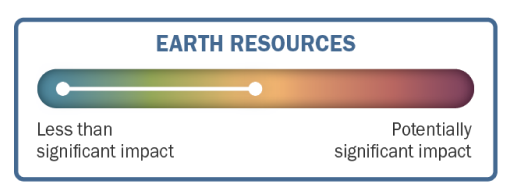
 Air Quality and Greenhouse Gases
Air Quality and Greenhouse Gases
Air quality refers to the condition of the breathable air and the presence of pollutants. Gases that trap heat in the atmosphere are called greenhouse gases because they capture heat radiated from the sun as it is reflected back into the atmosphere from the Earth.
View PEIS Section 4.4Key Findings
- Through compliance with laws and permits, and with implementation of actions that could avoid and reduce impacts, the construction, operation, and decommissioning of facilities would likely result in less than significant impacts on air quality.
- In general, per kg of hydrogen produced, electrolysis using all renewable energy sources for electricity would have the lowest amount of life-cycle greenhouse gas emissions. Impacts from electrolysis, steam methane reforming, pyrolysis, bio-gasification production and storage would range from less than significant impacts to potentially significant adverse impacts on life-cycle greenhouse gas emissions.
- Electrolysis using fossil fuel as a source of electricity, steam methane reforming, pyrolysis, and bio-gasification production may have significant unavoidable adverse impacts on life-cycle greenhouse gas emissions. Determining if mitigation options would reduce or eliminate impacts below significance would be dependent on the specific project and site.
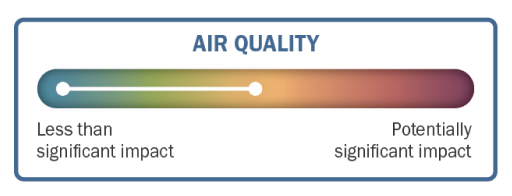
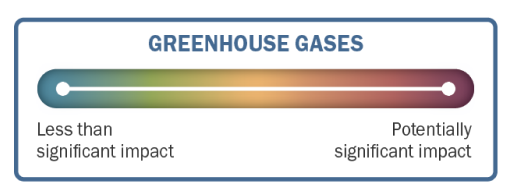
 Water Resources
Water Resources
Water resources include surface water, groundwater, wetlands, floodplains and frequently flooded areas, and water availability and water rights potentially affected by a facility.
View PEIS Section 4.5When choosing a site, developers will consider if resources needed for their project are available. The amount of water available will vary based on a project and its location and this study does not evaluate specific sites. If the water needed for a project to be built and operated is not available, the project would not be feasible.
Key Findings
- Through compliance with laws and permits, and with implementation of actions that could avoid and reduce impacts, the construction, operation, and decommissioning of facilities would likely result in less than significant impacts on water resources (surface water, groundwater, wetlands, floodplains, and water rights).
- No significant and unavoidable adverse impacts related to water resources would occur.
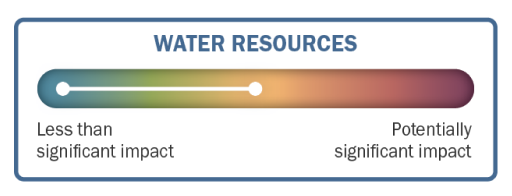
 Biological Resources
Biological Resources
Biological resources include aquatic and terrestrial habitats and species. Aquatic species—like fish and amphibians—are those that require water for some or all of their life cycle. Terrestrial species—mammals, birds, bats, reptiles, and plants—are those that live on land or use land habitats for the majority of their life cycle.
View PEIS Section 4.6Key Findings - Terrestrial and Aquatic Habitats and Species
- Some facilities would result in less than significant impacts.
- Facilities may result in potentially significant adverse impacts if activities cause or affect:
- Permanent degradation, loss, or conversion of suitable habitat that is crucial to species viability or disrupt habitat continuity along migration routes.
- Species viability, the mortality of any individual species, or disturbance that disrupts successful breeding and rearing behaviors.
- There may be potentially significant and unavoidable adverse impacts on terrestrial and aquatic special-status habitats and species.
- Determining if mitigation options would reduce or eliminate impacts below significance would be dependent on the specific project and site. Mitigation to reduce impacts below significance for terrestrial and aquatic special-status habitats or species may not be feasible.
Key Findings - Wetlands
Through compliance with laws and permits, and with implementation of actions that could avoid and reduce impacts, construction, operation, and decommission of green hydrogen production facilities would result in less than significant impacts to wetlands.
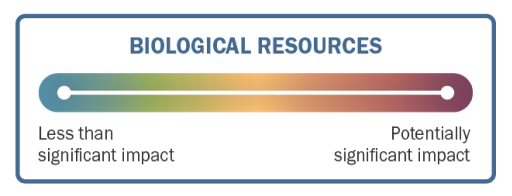
 Energy and Natural Resources
Energy and Natural Resources
The PEIS describes and evaluates the sources and availability of energy and natural resources such as fuel, building materials, and electricity.
View PEIS Section 4.7The energy and natural resources evaluated include the following:
- Electricity that is generated from renewable and non-renewable sources
- Renewable natural gas
- Biomass
- Transportation fuels including gasoline and diesel fuel
- Construction aggregate (the collective term for sand, gravel, and crushed stone)
Key Findings
- The PEIS assumes that a developer has contracted for sufficient electricity, renewable natural gas, and biomass. With this assumption, through compliance with laws and permits, and with implementation of actions that could avoid and reduce impacts, the construction, operation, and decommissioning of green hydrogen facilities would likely result in less than significant impacts on electricity supply and the availability of renewable natural gas or biomass fuels.
- There would also be less than significant impacts on fuels and construction aggregate.
- Electrolysis and bio-gasification facilities would have no impact on the availability of renewable natural gas fuels.
- Electrolysis, steam methane reforming, and pyrolysis facilities would have no impact on the availability of biomass fuels.
- No significant and unavoidable adverse impacts related to energy and natural resources would occur.
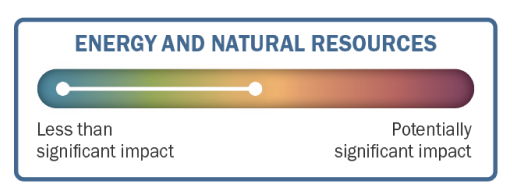
 Environmental Health and Safety
Environmental Health and Safety
Environmental health and safety refers to the risks or hazards that could affect the well-being of people. The PEIS evaluate hazardous materials and contaminants, physical safety risks, risks of wildfires, and other safety concerns.
View PEIS Section 4.8The impact analysis addressed the following types of impacts:
- Risks from use of hazardous materials for green hydrogen production
- Fire and explosion risks from green hydrogen facility operations
- Worker health and safety risks
Key Findings
- Through compliance with laws and permits, and with implementation of actions that could avoid and reduce impacts, most construction, operations, and decommissioning activities would likely result in less than significant impacts related to hazardous materials and health and safety.
- Depending on the specific location, severity, and emergency response capacity, operation activities would likely have less than significant to potentially significant adverse impacts from fires and explosions. The severity of risks would need to be assessed for each facility based on the project location, production method, and quantities of flammable materials produced or stored on-site.
- A thermal runaway event due to damage or battery management system failure at a facility with a co-located lithium-ion battery energy storage system (BESS) would likely have potentially significant adverse impacts related to hazardous air emissions.
- A facility may result in potentially significant and unavoidable adverse impacts if new ignition sources are in remote locations with limited response capabilities, or if a fire or explosion during operations spreads rapidly or impacts large areas. Determining if mitigation options would reduce or eliminate impacts below significance would be dependent on the specific project and site.
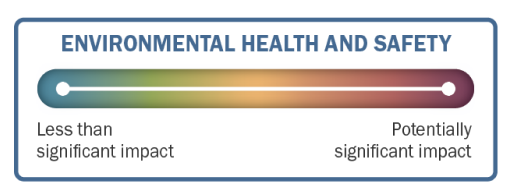
 Noise/Vibration
Noise/Vibration
Noise is unwanted sound that can affect people, fish, and wildlife. Vibration is motion through something solid, like the ground, which can affect living creatures or damage buildings.
View PEIS Section 4.9Key Findings
- Through compliance with laws and permits and with implementation of actions that could avoid and reduce impacts, most construction, operation, and decommissioning activities would likely result in less than significant impacts related to noise and vibration.
- Potentially significant adverse impacts related to vibration would occur if:
- Vibration from specific construction activities occurs at distances closer than 350 feet from residential land uses, or in close proximity to conventional or historic structures.
- If some types of blasting during construction are conducted within 2,000 feet of historic structures.
- No significant and unavoidable adverse impacts related to noise or vibration would occur.
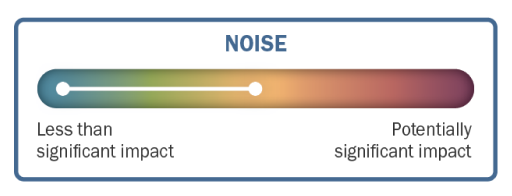
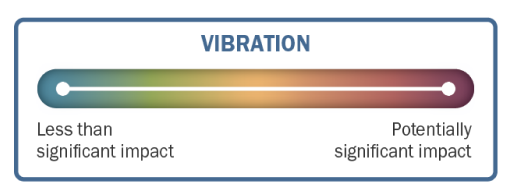
 Land Use
Land Use
Land use refers to how land is developed for human uses or preserved for natural purposes. For the PEIS, green hydrogen production facilities are assumed to be located on lands zoned and used for industrial development.
View PEIS Section 4.10Key Findings
- Through compliance with laws and permits, and with implementation of actions that could avoid and reduce impacts, construction, operation, and decommissioning activities would result in less than significant impacts on land use.
- No significant and unavoidable adverse impacts related to land use would occur.
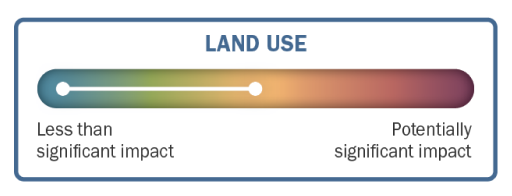
 Aesthetics/Visual Quality
Aesthetics/Visual Quality
Visual quality, or aesthetics, refers to natural and human landscapes and how people see them. A visual impact is a change or contrast that affects the scenic quality of a landscape.
View PEIS Section 4.11The PEIS evaluates the long-term change or reduction in visual quality and creation of new sources of light or glare that would adversely affect day or nighttime views in the area.
Key Findings
- Through compliance with laws and permits, and with implementation of actions that could avoid and reduce impacts, construction, operations, and decommissioning activities would likely result in less than significant impacts related to visual quality and light or glare.
- No significant and unavoidable adverse impacts related to aesthetics and visual quality would occur.
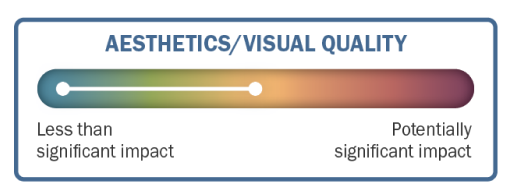
 Recreation
Recreation
Recreation provides people with the opportunity to engage with and enjoy the natural environment. Recreational opportunities in Washington include both land- and water-based activities in parks or other public or private lands.
View PEIS Section 4.12Key Findings
- Through compliance with laws and permits and with implementation of actions that could avoid and reduce impacts, construction, operations, and decommissioning activities would likely result in less than significant impacts on recreation.
- No significant and unavoidable adverse impacts related to recreation would occur.
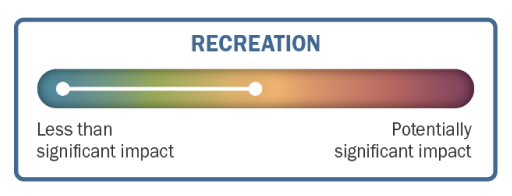
 Historic and Cultural Resources
Historic and Cultural Resources
Historic and cultural resources include archaeological resources, human remains, cemeteries, sacred sites, and traditional cultural properties.
View PEIS Section 4.13Key Findings
Facilities could impact historic and cultural resources. Each historic or cultural resource's significance is unique to that resource; therefore, the impact analysis will also be unique and would need to be conducted during future project-level review for facilities. The significance of impacts to Tribal cultural resources can be understood only from within the cultural context of an affected Tribe. Accordingly, impact assessment and determinations of significance or non-significance to Tribal cultural resources would be done with engagement and in consultation with Tribes and the Department of Archaeology and Historic Preservation at the project level.
 Transportation
Transportation
Transportation is the system of roads, transit routes, railroads, waterways, and airport facilities that move people and goods.
View PEIS Section 4.14This PEIS considers the transportation system; traffic, public transit, and non-motorized or other transportation system conflicts; and the movement of trucks, trains, or vessels to transport equipment for construction, operation, or decommissioning of green hydrogen facilities. Freight transportation modes are the focus of the PEIS. The PEIS does not evaluate the transportation or distribution of green hydrogen, or transportation related to the end uses of green hydrogen. This would be evaluated during project-level review.
Key Findings
- Through compliance with laws and permits and with implementation of actions that could avoid and reduce impacts, the construction, operation, and decommissioning of facilities would likely result in less than significant impacts on transportation.
- No significant and unavoidable adverse impacts related to transportation resources would occur.
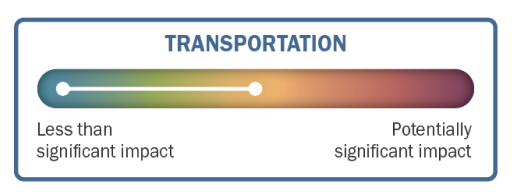
 Public Services and Utilities
Public Services and Utilities
Public services and utilities include basic services and facilities that support development and protect public health and safety. These include services like fire and emergency response, electrical power, water, wastewater, communications, and solid waste/recycling.
View PEIS Section 4.15A green hydrogen facility developer would need to ensure that there are sufficient utilities for a project available by establishing agreements with utility providers. A green hydrogen facility developer would also need to ensure that there is sufficient water available for a project, both physically and legally. The PEIS assumes that a project developer has contracted for sufficient electricity and renewable natural gas and obtained a water right as needed.
Key Findings
- Through compliance with laws and permits, and with implementation of actions that could avoid and reduce impacts, most construction, operation, and decommissioning activities would likely result in less than significant impacts on public services and utilities.
- A facility would result in potentially significant adverse impacts on emergency response if activities required a large emergency response in remote locations with limited response capabilities, a fire or explosion during operations spreads rapidly or impacts large areas, or if there are other unique aspects of a facility site.
- Potentially significant and unavoidable adverse impacts to emergency response may occur. Determining if mitigation options would reduce or eliminate impacts below significance would be dependent on the specific project and site.
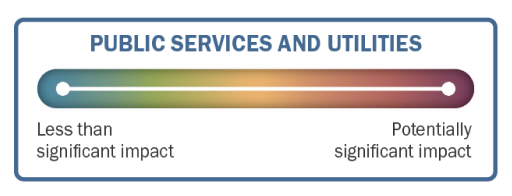
 Cumulative Impacts
Cumulative Impacts
Cumulative impacts result from the effects of a facility added to the impacts from past, present, and reasonably foreseeable future actions over time.
View PEIS Section 5Trends considered for cumulative impacts:
The impact analysis addressed the following types of impacts:
- Energy projects, including clean energy developers and changes to existing systems
- Urban, commercial, and industrial activities and development
- Rural and agricultural activities and development
- Federal, state, and local wildlife and habitat projects
- Transportation infrastructure development and modification
- Contaminated site cleanup and remediation
- Mining operations expansion, development, and reclamation activities
- Military use development and changes
- Water supply development and withdrawals for municipal, agricultural, industrial, and conservation uses
Key Findings
- Due to the large geographic study area and broad trends of RFFAs that are considered, cumulative impacts would range from less than significant to potentially significant. Future projects would need to conduct cumulative analyses relative to their proposal.
The extent and magnitude of impacts on resources would vary depending on the geographical region and size of the facility relative to other and reasonably foreseeable future actions in the area. In general, when considering the contribution of future effects, the larger the facility the greater the potential for cumulative impacts because of the larger footprint, the increased need for construction materials, and the increased scale of the supporting infrastructure. Conversely, smaller facilities are likely to result in fewer cumulative impacts on resources because they have a smaller footprint and require less supporting infrastructure.
Cumulative impacts would also vary depending on the production and storage method of green hydrogen and the inputs and outputs required of the facility. There is also increased potential for multiple green hydrogen and other clean energy generation facilities to be located proximate to one another for access to common infrastructure and users. An example of this is the nodes being proposed as part of the green hydrogen hub process. As a result, the combined impacts from construction, operation, and decommissioning of one or more of these facilities could result in cumulative impacts on the natural and built environment.
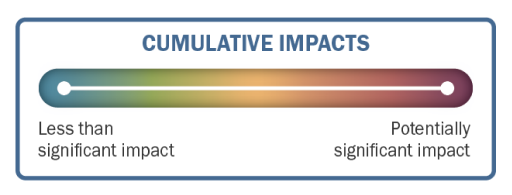
 Additional Resources
Additional Resources








